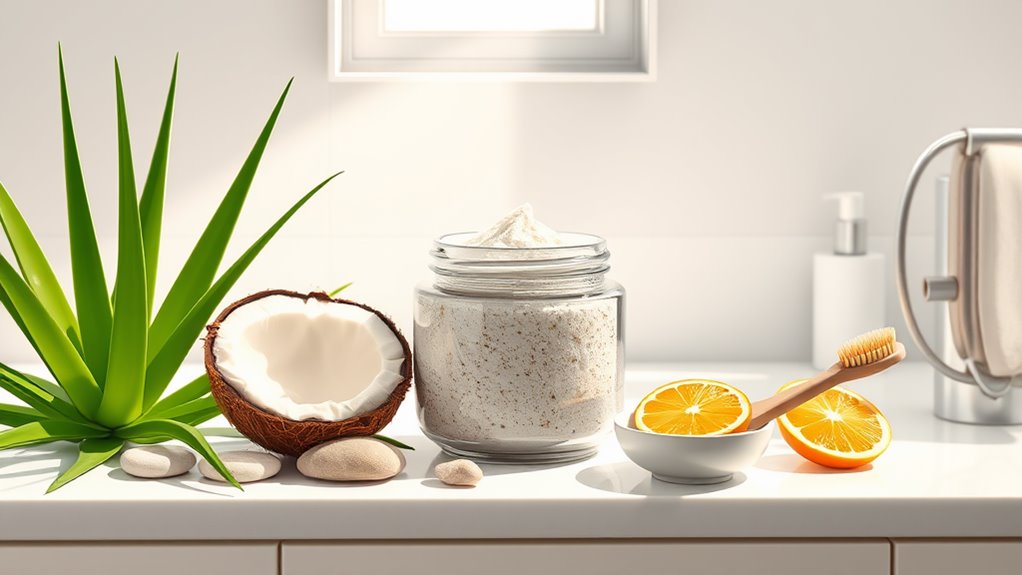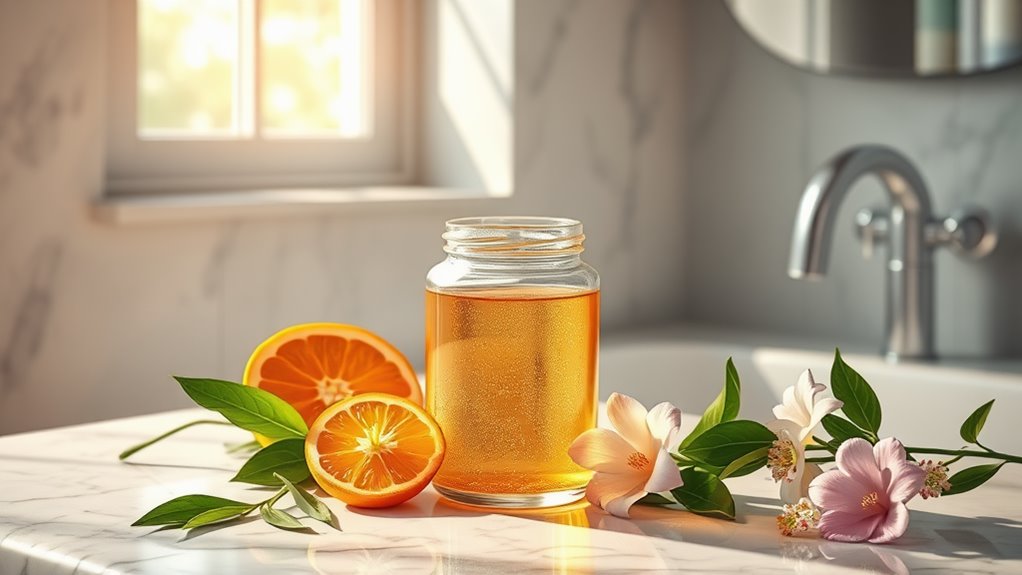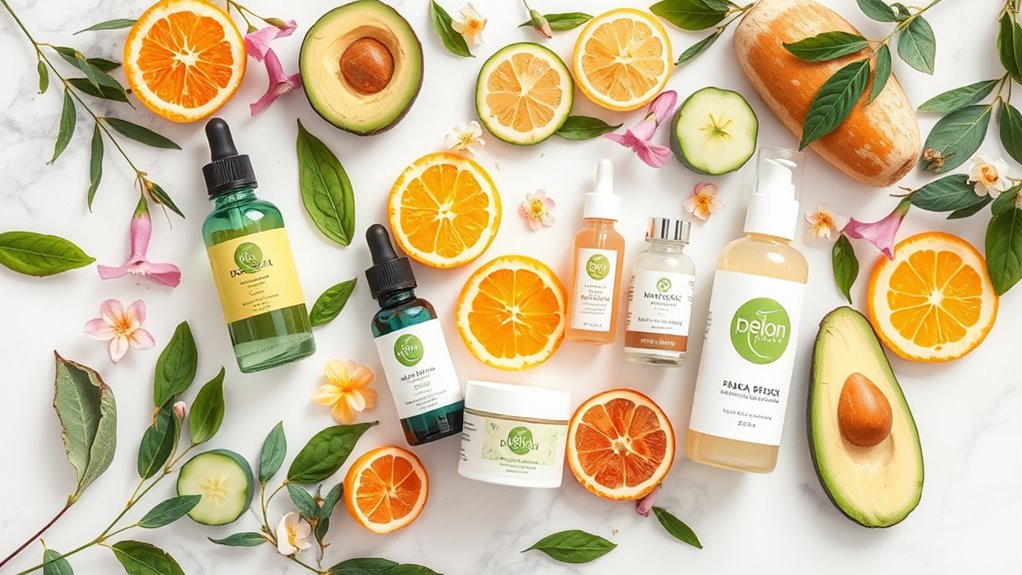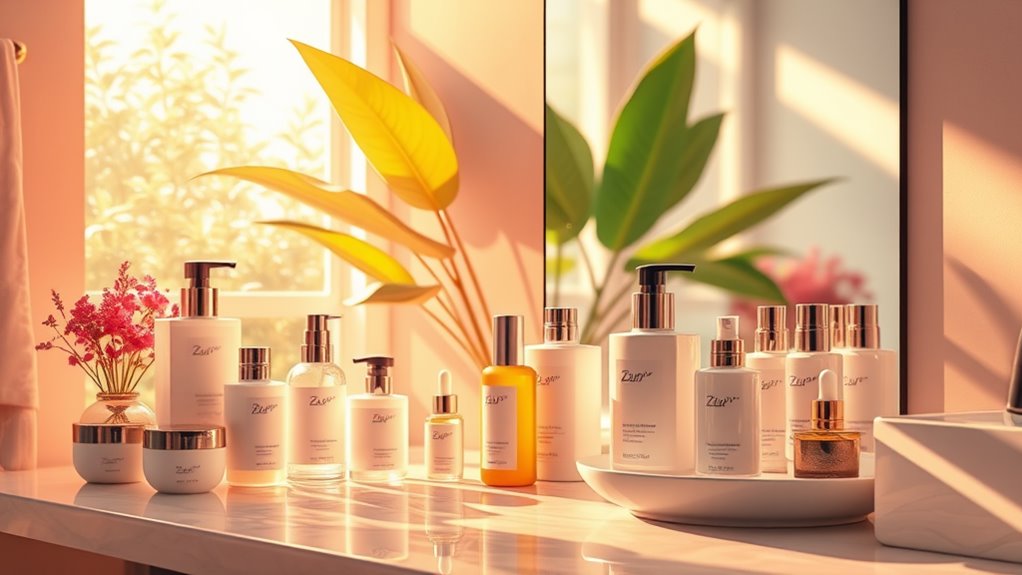This One Exfoliation Habit Changed Everything
If you’ve ever struggled with dull skin, you might want to contemplate a simple yet effective change: incorporating a gentle chemical exfoliant into your routine. Many people overlook the impact of exfoliation, thinking it’s just an extra step. But what if this habit could truly transform your complexion? The benefits go beyond just a radiant glow. Let’s explore how this approach can enhance your skincare journey and boost your confidence.
Key Takeaways
- Regularly exfoliating 1-3 times a week can transform skin texture and enhance radiance by removing dead skin cells.
- Incorporating gentle chemical exfoliants like lactic or salicylic acid helps promote cell turnover without irritation.
- Tailoring exfoliation frequency to your skin type prevents irritation and maintains a healthy balance of oils.
- Post-exfoliation hydration and sunscreen application protect and nourish skin, maximizing the benefits of exfoliation.
- Consistent exfoliation leads to visible improvements, such as reduced dark spots and smoother skin, boosting confidence and overall appearance.
Understanding Exfoliation and Its Importance
Although you mightn’t think about it often, exfoliation plays an essential role in maintaining healthy skin. It helps remove dead skin cells, promoting cell turnover and revealing a fresh, radiant complexion.
To master your exfoliation routine, try some effective exfoliation hacks. For instance, consider incorporating natural ingredients like sugar or coffee grounds into your scrubs. Alternatively, you can use a gentle chemical exfoliant with alpha or beta hydroxy acids to target specific skin concerns.
Regular exfoliation enhances product absorption, ensuring your serums and moisturizers work effectively. Just remember not to overdo it; a balanced approach is key. Additionally, common habits that accelerate skin aging can be mitigated by maintaining a consistent exfoliation routine.
The Difference Between Physical and Chemical Exfoliants
When choosing the right exfoliant for your skin, it’s essential to understand the differences between physical and chemical exfoliants.
Physical exfoliants, like scrubs and brushes, rely on abrasive particles to manually slough off dead skin cells. They offer immediate results but can sometimes cause microtears or irritation if used too aggressively.
On the other hand, chemical exfoliants use acids or enzymes to dissolve the bonds between dead skin cells, allowing them to shed naturally. These exfoliants, such as AHAs and BHAs, penetrate deeper and provide a more uniform exfoliation, often leading to smoother, brighter skin over time. Additionally, incorporating proven ingredients like vitamin C can enhance the effectiveness of your exfoliation routine by further targeting dark spots.
Understanding these distinctions helps you select an exfoliant that best suits your skin type and concerns, ensuring you achieve the best results without compromising your skin’s health.
Benefits of Switching to Gentle Chemical Exfoliants
Switching to gentle chemical exfoliants can bring a host of benefits for your skin. Unlike their harsher counterparts, these formulations work effectively without causing irritation or micro-tears.
You’ll notice smoother texture and enhanced radiance as they dissolve dead skin cells, unclog pores, and promote cell turnover. With regular use, you can achieve a more even skin tone and reduced appearance of fine lines and dark spots.
Gentle chemical exfoliants also support hydration, allowing your skin to better absorb serums and moisturizers. Plus, they’re suitable for all skin types, minimizing the risk of adverse reactions. Additionally, incorporating these exfoliants can enhance your skin’s ability to naturally reduce the appearance of dark spots, leading to a brighter complexion over time.
How to Choose the Right Chemical Exfoliant for Your Skin Type
How can you find the perfect chemical exfoliant for your skin type? Start by identifying your skin’s needs.
If you have oily or acne-prone skin, look for products containing salicylic acid, as it penetrates pores effectively.
For dry or sensitive skin, opt for gentle alpha hydroxy acids like lactic acid, which hydrate while exfoliating.
Combination skin may benefit from a balanced mix of both types.
Always check the pH level; a product between 3.5 to 4.5 is ideal for effectiveness without irritation.
Test a small area first to gauge your skin’s reaction.
Finally, remember that less is more—exfoliate once or twice a week to avoid overdoing it.
This approach guarantees you achieve glowing, healthy skin without compromising your skin barrier.
Recommended Products for Effective Chemical Exfoliation
Now that you’ve chosen the right chemical exfoliant for your skin type, let’s explore some popular products that can help you achieve glowing skin.
You’ll also want to learn a few application tips to maximize their effectiveness.
With the right approach, you can enjoy the benefits of chemical exfoliation safely and effectively.
Popular Chemical Exfoliants
Chemical exfoliants have become essential tools in the quest for radiant skin, offering a powerful alternative to traditional scrubs. AHA (alpha-hydroxy acids) and BHA (beta-hydroxy acids) are the most popular options.
AHAs, like glycolic and lactic acid, excel at hydrating and brightening, making them ideal for dry or sun-damaged skin. On the other hand, BHAs, particularly salicylic acid, penetrate deeper to clear clogged pores and reduce acne.
Consider products like The Ordinary’s Glycolic Acid 7% Toning Solution or Paula’s Choice 2% BHA Liquid Exfoliant for effective results. For a gentle touch, look into Pixi Glow Tonic, which combines both AHA and soothing ingredients.
Mastering these potent exfoliants can transform your skincare routine and elevate your complexion.
Application Tips for Success
To achieve the best results with chemical exfoliants, it’s crucial to apply them correctly.
Mastering the application process can amplify your skin’s radiance and texture. Here are some tips to guarantee success:
-
Patch Test: Always test a small area before full application to avoid adverse reactions.
-
Cleanse First: Start with a clean face to allow the exfoliant to penetrate effectively.
-
Use a Gentle Touch: Apply with light pressure, letting the product do the work.
-
Follow Instructions: Adhere to the recommended usage frequency; over-exfoliating can lead to irritation.
-
Moisturize After: Lock in hydration with a suitable moisturizer post-exfoliation to maintain skin balance.
Incorporating these practices will optimize your chemical exfoliation experience.
Building an Exfoliation Routine: Frequency and Timing
To build an effective exfoliation routine, start by determining your skin type.
This will help you choose the right exfoliant and establish how often you should use it.
Finding the perfect balance will keep your skin healthy and glowing.
Determine Skin Type
How can you build an effective exfoliation routine if you don’t know your skin type? Understanding your skin type is essential for tailoring your exfoliation approach. Here are some key characteristics to help you identify yours:
-
Oily Skin: Shiny appearance, enlarged pores, prone to breakouts.
-
Dry Skin: Flaky, tight, or rough texture, may feel irritated.
-
Combination Skin: Oily in the T-zone, dry or normal on cheeks.
-
Sensitive Skin: Reacts easily to products, prone to redness or irritation.
-
Normal Skin: Balanced, not too oily or dry, few imperfections.
Once you know your skin type, you can determine the frequency and timing of exfoliation to achieve ideal results without irritation.
Choose Exfoliant Type
Which exfoliant type suits your skin best?
To master your exfoliation routine, you need to choose wisely. Chemical exfoliants, like AHAs and BHAs, work by dissolving dead skin cells, making them ideal for uneven texture or acne.
If you prefer a physical approach, opt for gentle scrubs with fine particles—they’re perfect for an immediate glow but be cautious with sensitive skin.
For those seeking a more advanced option, consider enzyme exfoliants; they’re effective and gentle, breaking down dead cells without abrasion.
Remember, your choice should align with your skin’s needs and concerns.
Establish Ideal Frequency
Finding the right exfoliation frequency is essential for maintaining healthy skin without causing irritation. Depending on your skin type and the exfoliant you choose, striking the perfect balance can transform your routine.
Here are some guidelines to help you establish your ideal frequency:
-
Oily skin: Exfoliate 2-3 times a week to combat excess sebum.
-
Dry or sensitive skin: Limit exfoliation to once a week to prevent further dryness.
-
Combination skin: Aim for 1-2 times a week, adjusting based on areas of concern.
-
Active acne: Consult a dermatologist; frequent exfoliation can exacerbate irritation.
-
Chemical exfoliants: Use them cautiously; start with weekly applications, increasing as tolerated.
Master your routine, listen to your skin, and adjust as needed for best results.
Common Mistakes to Avoid When Exfoliating
Many people overlook the importance of proper exfoliation techniques, leading to common mistakes that can harm your skin. One major error is over-exfoliating. You might think more is better, but excessive scrubbing can strip your skin of essential oils, causing irritation.
Another mistake is using harsh tools; abrasive scrubs or rough brushes can damage your skin barrier. Don’t forget to pay attention to your skin type; using products not suited for your specific needs can exacerbate issues.
Also, avoid exfoliating on compromised skin, like when you have active breakouts or sunburn. Finally, neglecting your skin’s hydration post-exfoliation can lead to dryness.
Mastering these techniques guarantees you reap the full benefits of exfoliation without compromising your skin’s health.
The Role of Moisturizers and Sunscreen After Exfoliation
After exfoliating, it’s essential to replenish your skin with moisturizers and protect it with sunscreen. Exfoliation can leave your skin vulnerable, so these post-care steps are important for maintaining its health and radiance.
Here’s what you should focus on:
-
Choose a hydrating moisturizer**** that suits your skin type to lock in moisture.
-
Opt for non-comedogenic products**** to prevent clogged pores, especially after exfoliation.
-
Use a broad-spectrum sunscreen**** with at least SPF 30 to shield your skin from harmful UV rays.
-
Reapply sunscreen every two hours, particularly if you’re outdoors, to guarantee ongoing protection.
-
Consider antioxidants in your moisturizer for added defense against environmental stressors.
Real-Life Transformations: Success Stories From Exfoliation Changes
Exfoliation can be a game-changer for your skin, and countless individuals have experienced remarkable transformations by incorporating it into their skincare routines.
Take Sarah, for example. Once plagued by dullness and uneven texture, she committed to weekly exfoliation and saw her complexion brighten and smooth out within weeks.
Then there’s Mark, who struggled with acne scars. After diligently exfoliating, he noticed significant fading of those scars, boosting his confidence and encouraging him to embrace a more active lifestyle.
These stories illustrate that with consistent effort and the right techniques, you can reveal your skin’s potential.
Frequently Asked Questions
Can I Exfoliate While Pregnant or Breastfeeding?
You can exfoliate while pregnant or breastfeeding, but choose gentle products. Avoid harsh chemicals and large beads. Always consult your healthcare provider to guarantee safety for both you and your baby during your skincare routine.
Is Exfoliation Safe for Sensitive Skin?
Exfoliation can be safe for sensitive skin, but you should choose gentle methods. Listen to your skin’s reactions, and avoid harsh scrubs. Hydrating ingredients and chemical exfoliants might work better for your delicate complexion.
How Do I Know if I’m Over-Exfoliating?
You’ll know you’re over-exfoliating if your skin feels irritated, looks red, or becomes excessively dry. Pay attention to your skin’s reaction, and adjust your routine by reducing frequency or switching to gentler products.
Can Exfoliation Help With Acne Scars?
Exfoliation can definitely help with acne scars by promoting cell turnover and revealing fresher skin. Just be careful not to overdo it; balance is key to achieving the best results without irritation or damage.
Are There Natural Alternatives to Chemical Exfoliants?
Yes, there are natural alternatives to chemical exfoliants. You can use ingredients like sugar, coffee grounds, or oatmeal for gentle exfoliation. These options offer effective results without harsh chemicals while nourishing your skin.
Conclusion
Incorporating a gentle chemical exfoliant into your skincare routine can truly transform your complexion. With regular use, you’ll notice brighter skin, improved texture, and enhanced moisture absorption. Remember to choose the right product for your skin type and stick to a consistent routine. Don’t forget to follow up with a good moisturizer and sunscreen to protect your newly radiant skin. Embrace this simple habit and watch your confidence soar as you enjoy your glowing transformation!





